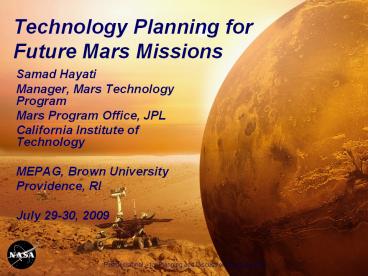Technology Planning for Future Mars Missions - PowerPoint PPT Presentation
1 / 13
Title:
Technology Planning for Future Mars Missions
Description:
Technology Planning for Future Mars Missions Samad Hayati Manager, Mars Technology Program Mars Program Office, JPL California Institute of Technology – PowerPoint PPT presentation
Number of Views:296
Avg rating:3.0/5.0
Title: Technology Planning for Future Mars Missions
1
Technology Planning for Future Mars Missions
- Samad Hayati
- Manager, Mars Technology Program
- Mars Program Office, JPL
- California Institute of Technology
- MEPAG, Brown University
- Providence, RI
- July 29-30, 2009
2
Outline
- Candidate future missions
- Technologies for future missions
- Maturity and priority of identified technologies
- Schedule
3
Future Missions Considered
4
Candidate Future Mission Concepts
- 2016 Trace Gas Orbiter Mission
- 2018 or 2020 Mid-Range Rover Mission
- 2018 or 2020 Net Lander Mission
- 2022 Mars Sample Return Mission
5
Mid-Ranger Rover Mission Concept
- In-situ exploration
- Cache samples for a future mission to return to
earth - Obtain 5 cores from each region
- Total of 20 samples
- Encapsulate samples
- Store samples in a canister
- Avoid contaminating samples from Earth based
contaminants
0.5 km
Landing Target
Landing Error
6
MRR Mission Concept Technologies Precision
Landing
- Precision Landing
- Many error sources contribute to the landing
error - Guided entry on MSL utilizes its onboard IMU and
flies the S/C to zero out known deviations from
the target - Major contributors to the remaining error are
- IMU initialization error
- Drift due to winds during parachute phase of
descent - Current best estimate is that the landing error
could be reduced to 7km. - Advantage of this technique is that additional
fuel would not required to reduce errors - Technology development would consist of accurate
modeling and simulation taking into consideration
realistic conditions to validate this concept - If MRR carries an upward looking LIDAR to measure
winds, MSR lander may be able to use that
information to increase its landing precision
7
MRR Mission Concept Technologies Hazard
Avoidance
- Hazard Avoidance
- If hazard avoidance is utilized, science targets
might be selected within landing error ellipse - Technology
- Terrain Relative Navigation (TRN) could be
utilized to image the terrain and use onboard
maps to determine the actual position of S/C - Optimal descent guidance could be used to divert
S/C to a safe landing location
Hazard Avoidance
Landing Target
Original trajectory
Modified trajectory
Landing Error
8
MRR Mission Concept TechnologiesSample
Acquisition, Encapsulation, and Handling
- Mini Corer CAT Designed for MSL
- Honeybee Robotics
MRR Sample Handling Concept
- Coring 1cmX 5, at least 20 cores
- Low-mass, low-power drill
- Dry drilling
- Coring initialization
- Core break-off
- Core retention
- Core encapsulation
- Core storage
- Contamination prevention
9
MRR Mission Concept Technologies Rover
Technologies
0.5 km
Landing Target
- Mid-Range Rover Concept
- Total traverse 75x0.50.5 10 km
- Selection of regions for sampling 10sols/region
- Sampling 5sols/sampleX20 100 sols
- Sols available for traverse (355-140)x0.7 150
sols - Required Traverse speed 10000/140 67 m/sol
- Fetch Rover Concept
- Required Traverse speed 12000/15080 m/sol
- MER Example
- Maximum possible (mechanical and power) 252
m/sol - Maximum possible with VO and Auto nav 29 m/sol
- Need roughly a three-fold improvement in rover
speed
7 km
- Technology Approach
- Increase rover drive distances and average speed,
by eliminating the need for rovers to stop while
performing autonomous navigation and visual
odometry. - Implement FPGA based stereo and visual odometry
and improved Autonav
10
MRR Mission Concept Technologies Planetary
Protection (Round Trip Contamination)
- Two approaches might be available
- Dry Heat Microbial Reduction (DHMR) terminal
sterilization - Consists of heating the entire S/C to 1120 C for
30 hours - Technology challenges are
- Hardware compatibility
- Chamber design large enough to accommodate S/C
- Full system bio-barrier to avoid recontamination
- Component and Subsystem Sterilization
- Component level sterilization of relevant
subsystems by DHMR or other methods such as
hydrogen peroxide or irradiation - Clean-assembly strategy to avoid recontamination
- Bio-barriers
- Analytical tools to accurately estimate
contamination risks post landing to satisfy
probabilistic requirements
11
Technologies for Mars Sample Return Mission
Concept
- Rover Technology
- Increase rover speed for traversing long distance
- Rover avionics for low-mass low, low-power fetch
rover
Mars Ascent Vehicle (MAV) Develop a lt300kg
ascent vehicle to lift a 5kg sample container
(0.5 kg samples) to a 500 km Mars orbit
Sample Acquisition, Transfer, and Encapsulation
Would require coring from a small rover,
automated tool change out, and encapsulation
capabilities
Earth Entry Vehicle Develop an Earth Return
Vehicle to safely deliver Martian samples to
Earth. Satisfy stringent back planetary
requirements
Back Planetary Protection Meet the goal of less
than10-6 probability of inadvertent release of a
single Mars particle gt 0.2 micron in the Earths
biosphere
Rendezvous and Sample Capture Develop
capabilities to track, rendezvous, and capture a
small (16cm diameter) Orbiting Sample in Mars
orbit autonomously
Round-Trip PP Full system microbial reduction
methods to prevent Mars sample contamination
Mars Returned Ground Sample Handling Develop
capabilities to safely handle Martian samples
Avoid contaminating samples and assure containment
Precision and Safe Landing Reduce landing error
to 6-7 km and develop hazard avoidance
capabilities for proposed MSR lander
12
Technology Risks
Back PP
Sample Acquisition Handling
Mid-Range Rover Mission Concept
Round Trip PP
Component Technology Risk
Rendezvous Sample Capture
Precision or Pin-point Landing
MAV
MRSH
EEV
System Technology Risk
13
Example Schedule































